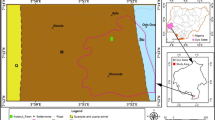Abstract
Soil maps identifying spatial distributions of soil textural features are needed to implement precision agriculture in practice. This study examined the use of soil electrical conductivity recalculated to a soil temperature of 25 °C (EC25) to generate a soil textural map. The examinations were conducted at 16 soil monitoring sites distributed throughout the State of Brandenburg (Germany) which has 1.35 Mha farmland. Descriptions of 413 soil profiles already existed for these sites. They were the basis for calculating the textural features of weighted clay content, weighted silt content and soil textural class type. The soil electrical conductivity was measured using the EM38 instrument at the same locations and under defined measuring conditions. If gleysols were excluded, the coefficient of determination for the regression function between weighted clay content and EC25 was 0.55. A factor score comprising weighted clay and silt contents showed a closer connection with the EC25 (R 2 = 0.67). This means that the weighted silt content also influenced soil electrical conductivity. EC25-values between 0 and 10 mS/m could be allocated to sand or loamy sand profiles, EC25-values between 10 and 20 mS/m to sand or loamy sand over loam profiles, and EC25-values between 20 and 30 mS/m to sandy loam or loam profiles.
Similar content being viewed by others
References
Boden, AG 1994. Bodenkundliche Kartieranleitung (soil survey instruction), edited by Bundesanstalt für Geowissenschaften und Rohstoffe und den Geologischen Landesämtern in der Bundesrepublik Deutschland, Hannover (E. Schweizerbart'sche Verlagsbuchhandlung, Johannesstraße 3 A, 70176 Stuttgart, Germany).
Dalgaard, M., Have, H. and Nehmdahl, H. 2001. Soil clay mapping by measurement of electromagnetic conductivity. In: Proceedings of Third Europeanficonference on Precision Agriculture, edited by G. Grenier and S. Blackmore, (agro Montpellier, France), pp. 367–372.
Domsch, H., Lück, E. and Eisenreich, M. 1999. Determination of the electrical soilficonductivity with the Geonics EM38 for the identification of the soil types distribution. In: Tagung Landtechnik 1999 (Conference Agricultural Engineering) VDI-Bericht 1503), edited by VDI/MEG (VDI-Verl. Düsseldorf, Germany), pp. 181–186.
Domsch, H. and Kuhn, R. 1999. Use of the global positioning system to determine field loading by transport vehicles. In: Proceedings of the International Workshop Agricultural Transport, edited by G. Weise (Justus-Liebig Universität Giessen, Germany), pp. 39–49.
Durlesser, H. 1999. Bestimmung der Variation bodenphysikalischer Parameter in Raum und Zeit mit elektromagnetischen Induktionsverfahren. (Determination of soil physical properties variation in space and time using electromagnetic induction methods) (Shaker Verlag Aachen, Germany (FAM-Bericht; Bd. 53) together Diss. Techn. Univ. München).
Geonics Limited, 1999. EM38 —Groundficonductivity meter —Operating manual, Mississauga, Ontario, Canada).
Han, S., Hummel, J. W., Goering, C. E. and Cahn, M. D. 1994. Cell size selection for site-specificficrop management. Transaction of the ASAE 37, 19–26
James, I. T., Waine, T. W., Bradley, R. I., Godwin, R. J. and Taylor, J.C. 2000. Acomparison between traditional methods and EMI scanning for determining soil textural boundaries. AGENG 2000, Paper 00-PA-014, Warwick, UK.
King, J. A., Dampney, P. M. R., Lark, M., Mayr, T. R. and Bradley, R. I. 2001. Sensing soil spatial variability by electro-magnetic induction (EMI):Its potential in Precision Farming. In: Proceedings of Third Europeanficonference on Precision Agriculture, edited by G. Grenier and S. Blackmore, (agro Montpellier, France), pp. 419–424.
Lück, E. and Eisenreich, M. 2001. Electricalficonductivity mapping for precision agriculture. In: Proceedings of Third Europeanficonference on Precision Agriculture, edited by G. Grenier and S. Blackmore, (agro Montpellier, France), pp. 425–429.
Lund, E. D., Colin, P. E., Christy, D. and Drummond P. E., 1998. Applying soil electricalficonductivity technology to Precision Agriculture. In: Proceedings of the fourth Internationalficonference on Precision Agriculture, edited by P.C. Robert, R. H. Rust and W. E. Larson, (ASA-CSSA-SSSA, Madison, WI, USA), pp. 1089–1100.
Lund,E.D.,Christy,C.D.,Drummond,P.E.1999. Practical applications of soil electricalficonductivity mapping. In: Precision Agriculture '99: Proceedings of the 2nd Europeanficonference on Precision Agriculture, edited by J. V. Stafford, (Sheffeld Academic Press, Sheffeld, UK) pp. 771–779.
McNeill, J. D. 1980a. Electricalficonductivity of soils and rocks (Geonics Ltd., Mississauga, Ontario, Canada, Technical Note TN-5).
McNeill, J. D. 1980b. Electromagnetic terrainficonductivity measurement at low induction numbers. (Geonics Ltd., Mississauga, Ontario,Canada, Technical Note TN-6).
Neudecker, E., Schmidhalter, U., Sperl, C. and Selige, T. 2001. Site-specific soil mapping by electromagnetic induction. In: Proceedings of Third Europeanficonference on Precision Agriculture, edited by G. Grenier and S. Blackmore (agro Montpellier, France), pp. 271–276.
Schmidhalter, U., Zintel, A. and Neudecker, E. 2001. Calibration of electromagnetic induction measurements to survey the spatial variability of soils. In: Proceedings of Third Europeanficonference on Precision Agriculture, edited by G. Grenier and S. Blackmore (agro Montpellier, France), pp. 479–484.
Sheets, K. R. and Hendrickx, J. M. H. 1995. Non-invasive soil waterficontent measurement using electromagnetic induction. Water Resources Research 31, 2401–2409.
SPSS 1998. SPSS® Base 8. 0 Applications Guide. SPSS Inc.
Sudduth, K. A., Drummond, S. T. and Kitchen, N. R. 2001. Accuracy issues in electromagnetic induction sensing of soil electricalficonductivity for precision agriculture. Computers and Electronics in Agriculture 31, 239–264.
Wayne, T. W., Blackmore, B. S. and Godwin, R. J. 2000. Mapping available waterficontent and estimating soil texturalficlass using electro-magnetic induction. AGENG 2000, Paper 00-SW-044, Warwick, UK.
Author information
Authors and Affiliations
Rights and permissions
About this article
Cite this article
Domsch, H., Giebel, A. Estimation of Soil Textural Features from Soil Electrical Conductivity Recorded Using the EM38. Precision Agriculture 5, 389–409 (2004). https://doi.org/10.1023/B:PRAG.0000040807.18932.80
Issue Date:
DOI: https://doi.org/10.1023/B:PRAG.0000040807.18932.80




